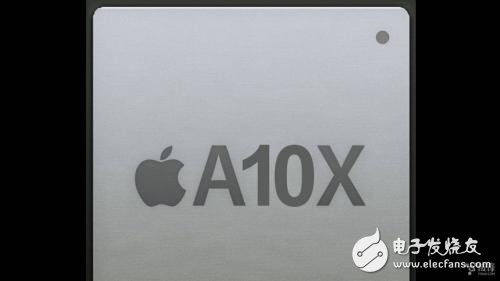Since it is aimed at high-end positioning, the performance of the iPad Pro is definitely to pursue the higher the better. With the A10X chip, the 2017 new iPad Pro has become even more powerful. In addition to knowing "powerful", what else can we learn about A10X? And when the new iPad Pro chip is understood by us, can we follow the clues related to A11? New iPad new chip At the WWDC Developers Conference in 2017, the 10.5-inch iPad Pro, which has been seen in the past, has finally been released, and the 12.-inch version has been updated. At the same time, of course, the latest A10X Fusion chip. Every time Apple launches a new system-on-a-chip, its performance is very worthy of attention. According to the official information, compared to the previous generation, the new iPad Pro's CPU speed is increased by 30%, while the graphics processor has a 40% improvement. Compared with the A10 Fusion, the A10X Fusion chip has four cores and six cores. It uses a 3+3 design, which is half of the high-performance core and energy-efficient core, and 12 are GPUs. In Apple's own words, its "amazing processing power" makes it easy to edit 4K video, and renders sophisticated 3D models to create and mark complex document documents. After the conference, the results of the A10X's running points were also exposed. According to the data, its single-threaded single-core running score is 3832 points, while the multi-core part reaches 9091 points, which can be said to be quite powerful, enough to make competitors sweat. After knowing this information, people still have questions. Does the A10X Fusion chip use TSMC's 10nm process? After announcing that it no longer relies on ImaginaTIon's GPU intellectual property, has it begun to adopt self-developed technology? Fortunately, A10X Fusion's "Aoyama Real Face" was finally exposed, so let's take a look at what it contains. Not long ago, TechInsights outside the station conducted a more in-depth analysis of the A10X Fusion chip on the new iPad Pro, so that we can finally see the true meaning of Apple's latest system on chip. First we can be sure that the A10X Fusion does use TSMC's 10nm FinFET process - one of the biggest questions is answered. Although this result is actually expected by many people, after all, Apple has always been eager to promote the development of chip design and manufacturing processes, they have this resource to take risks, and the profit margin of equipment is high enough. But in any case, the A10X is the first consumer-grade device to use a 10nm system-on-chip. Surprisingly, it is geared toward high-end, and in general such components are smaller and cheaper at first, to avoid the impact of early capacity shortages. This seems to reflect Apple's confidence. Interestingly, the A10X is a small, large chip. It's big enough for a 10nm system-on-chip, but it's very small from the Apple X-series standard. Just 96.4mm? The area is 125mm better than the A10 Fusion? The area is 24% smaller than the A9's 104.5mm? Both are 9% smaller. Compared with the A9X chip of the previous generation iPad Pro, it is 34% smaller. It can be said that this is the smallest iPad chip that Apple brings. However, it should be noted that the architecture of the A10X is, in a sense, an improved version of the A10. The biggest reason A10X has become so small is probably because it is conservative in design. The A10X has 3 pairs of CPU cores, while the A10 has 2 pairs, all with 8MB of L2 cache. The A9X is powered by a 12-core GPU, and the A10X is no different in design. Then it can be explained that Apple is at least not yet starting to maximize the chip space boost brought by the 10nm process, perhaps to leave room for future upgrades. But there is no doubt that the A10X is not a small A9X. TechInsights' chip "anatomy" is still not very clear enough to distinguish more detailed layout planning, but experts can still judge that the layout is a 12-core GPU cluster on the left and the CPU core on the right. This is not an accident, but it shows that the design of the GPU part has not changed much in general. The biggest change in the A10X comes from the CPU part, which makes its chip size smaller and more powerful than the A9X. Speaking of the GPU, then it is back to the question just now, that is, whether Apple has used the technology of ImaginaTIon, or has turned to self-research. At this point, Apple will certainly not be officially stated, but at least it is certain that it has confirmed that "the future" will no longer use ImaginaTIon's technology, and that the company can basically consider it as a fact. Apple will use the self-developed GPU sooner or later. The question is whether this "morning and evening" will be the present. We need to find the answer from Apple's developer documentation. In the file, Apple put the A10X's GPU into the iOS GPU Family 3 category, which includes all the on-chip systems of the A9 and A10 families. So from a functional point of view, the GPU part of the A10X chip doesn't have anything new. And TechInsights also mentioned that the A10X's GPU cluster looks almost exactly the same as the A9X, so we might think that their basic design is actually the same. As we just said, the focus of the A10X chip is not on the GPU, but on the CPU. So while its GPU performance has improved, it's hard to find out more interesting things. However, Apple is now pushing the independent development of GPUs, which will lead to more targeted functional integration. Although the A10X may not bring surprises in this regard, the future development is actually worth looking forward to. Although the performance of the new iPad Pro has improved significantly compared to the previous generation, it is mainly due to the progress of the process. From the above analysis, Apple's design is still conservative, and it leaves a lot of room for itself in the subsequent improvement. Considering that the company's real highlight is a new generation of iPhone, it may invest more. The iPad Pro is the first to introduce a 10nm process. It can only be said that it is a sentinel battle. So what will happen to the A11 of the iPhone 8 next? First of all, it is affirmative to adopt the 10nm process. Apple has already previewed it for us through the iPad Pro. However, A11 should also adopt the 2+2 core design, which combines two high performances and two energy-efficient combinations. But the core of A11 should be bigger and more energy efficient. On the A10X, Apple didn't take the benefits of the 10nm process to the extreme, and on the A11 it should be serious. If Apple can work harder to update the design and cooperate with the new 10nm process, we will surely usher in the generation of performance explosions. In addition, considering that the next-generation iPhone is likely to bring a 3D camera, the image signal processor should also be updated. The iPhone 8 is about to bring us major design changes, and this is not only external, it is likely to have internal evolution. The iPad Pro and its A10X have already hinted at this, and the real upgrade will be seen in the A11. Kitchen Range Hood Motor,Range Hood Motor,Kitchen Range Hood,Range Hood Fan Motor WUJIANG JINLONG ELECTRIC APPLIANCE CO., LTD , https://www.jinlongmotor.com
